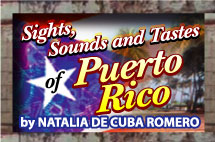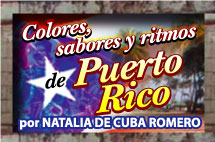|
Esta página no está disponible en español.

|
PUERTO RICO HERALD
If at First You Don’t Fricassee, Fry, Fry Again
By Natalia de Cuba Romero
|

|
March 21, 2003
Copyright © 2003 PUERTO RICO HERALD. All Rights Reserved.
 One of my favorite chapters in Magali García Ramis’ book of observations on Puerto Rican life, La ciudad que nos habita (The City that Inhabits Us), is called "La manteca que nos une" or "The Lard that Unifies Us." It is a riotous deconstruction of our shared love for fried and flavourful food and how it glues our society together. One of my favorite chapters in Magali García Ramis’ book of observations on Puerto Rican life, La ciudad que nos habita (The City that Inhabits Us), is called "La manteca que nos une" or "The Lard that Unifies Us." It is a riotous deconstruction of our shared love for fried and flavourful food and how it glues our society together.
And, it’s all true. How many times have I got off a plane at Luis Muñoz Marín International and headed straight for my fix: the beach shacks of Piñones where goddesses in pink rollers deep-fry alcapurrías (plantain fritters) and bacalaitos (cod fritters) in blackened cauldrons. Washed down with a cold beer, they make magic moments.
Yeah, I know better. We all do. We should be eating lighter, laying off the grease, cutting out the snacks, controlling cholesterol. And I do. Most of the time.
But sometimes virtue is boring. And when I deserve a comfort food banquet in the grand tradition of abuelitas of the boricua persuasion, I head for a fonda — a workman’s lunch joint, where the flavors are big, the portions are brawny and diets are for sissies.
You’ll usually need some Spanish to take full advantage of a fonda. To get you going: comida criolla means creole food and most of Puerto Rican creole is a blend of African, Taíno and Spanish techniques and ingredients. It is highly seasoned, but not spicy-hot; Puerto Ricans add the heat at the table in the form of pique, homemade pepper sauce.
Cilantro, onions, garlic, peppers and culantro are sautéed to make sofrito — the foundation of creole flavor.
As I tell you about some of my favourite fondas, I’ll be including some of the principal dishes and their translations. And first we’ll head for a place that translates the menu into English and has a number of bilingual wait persons.
La Fonda El Jibarito (787-725-8375) has been serving comida criolla on Calle Sol in Old San Juan for almost 30 years and looks to be doing it for at least 30 more. The menu changes every day, but owner Pedro J. Ruiz says the neophyte should try carne guisada (stewed beef) with arroz con habichuelas (white rice served separately from beans, usually pink, in a thick sauce) salad and tostones (fried green plantain disks that are Puerto Rican French fries). I personally love their fricase (stew) de pollo (chicken), conejo (rabbit) or ternera (veal). It’s open 11 am — 9 pm, seven days.
Restaurant El Popular (787-722-4653) on the Plaza del Mercado in Santurce is a preferred refueling stop for many of San Juan’s top chefs. The kitchen’s open from 7 am — 4 pm Monday —Saturday. Their chicharrones de pollo (fried chicken pieces) give good crunch, but for a real over-the-top experience get there Saturday before 2 pm for the Olla Española, an outrageous stew of 7 meats (including chicken, beef, pork, pork feet, veal, chorizo sausage and ham) plus tubers that goes for $5. Other entrees are about $5 and come with papas (potatoes), mofongo (mashed green plaintain with garlic and pork cracklings), tostones or rice and beans. On Fridays stick around for the live music street party on the plaza.
Casita Blanca (787-726-5501) is the most charming of these fondas, although the neighbourhood around 351 Tapia Street is a bit dodgy. Located in an old white wooden house, meals are served in enameled tin. Perhaps the best way to try Casita Blanca is at their Sunday buffet from noon — 5 pm (arrive early!). A counter is crowded with big old pots of delicious stuff like patitas de cerdo con garbanzos (pigs feet with chickpeas — okay so I hate them myself, but word is they do them well), pollo al ajillo (chicken in garlic), two kinds of bacalao (salt cod), pastelón de amarillos (mince meat sandwiched in fried sweet plantain) and several varieties of rices and bean dishes. All you can eat for $11.95!
Finally, Bebo’s (726-1008) at the corner of Loíza and Del Parque Streets in Santurce is a lot newer and more modern than the others and has a Dominican bent, but their criolla food is as authentic as any. Their sopa de pollo (chicken soup) is so good that I bring it back to Mayagüez with me in big tubs. Their serenata (salt cod in vinaigrette with potatos and local tubers) can bring me to tears. Their tostones are arguably the best I’ve ever had. Their pavo al horno (roast turkey) is astoundingly juicy. It’s hard to go wrong at Bebo’s, especially with most daily specials going for $6.
A few more key Spanish words for adventuring in fondas. The health conscious will want to know a la parrilla o a la brasa (grilled) and that ensalada (salad) usually means a slab of iceberg lettuce and a pathetic slice of tomato. Frito means fried. Pescado is fish and chillo is snapper. Carne de res is beef. Cerdo is pork. Bistec is beefsteak usually sauteed with cebollas (onions) Asopao is soupy chicken with camarones (shrimp), pollo or langosta (lobster) and rice. Amarillos are sweet fried plantains. Yuca is the local version of potato.
So buen provecho (good appetite)! See you at Weight Watchers!
Natalia de Cuba Romero is a freelance travel, food and arts writer. Her column, "Sights, Sounds & Tastes of Puerto Rico", appears weekly in the Puerto Rico Herald. She can be reached at NataliaHerald@centennialpr.net.
| 


